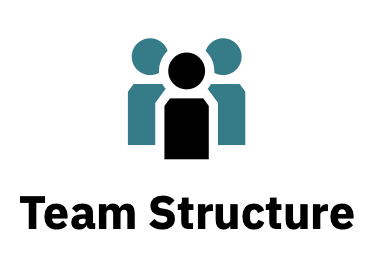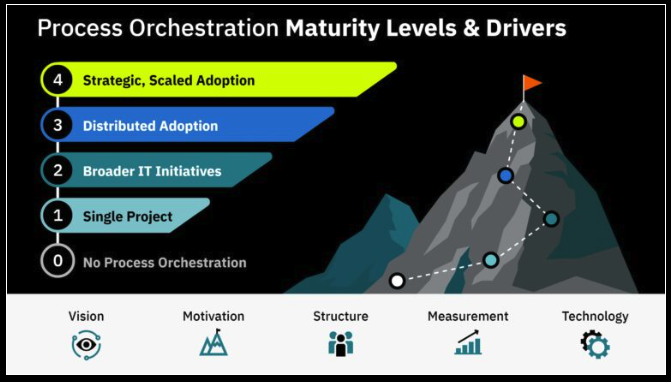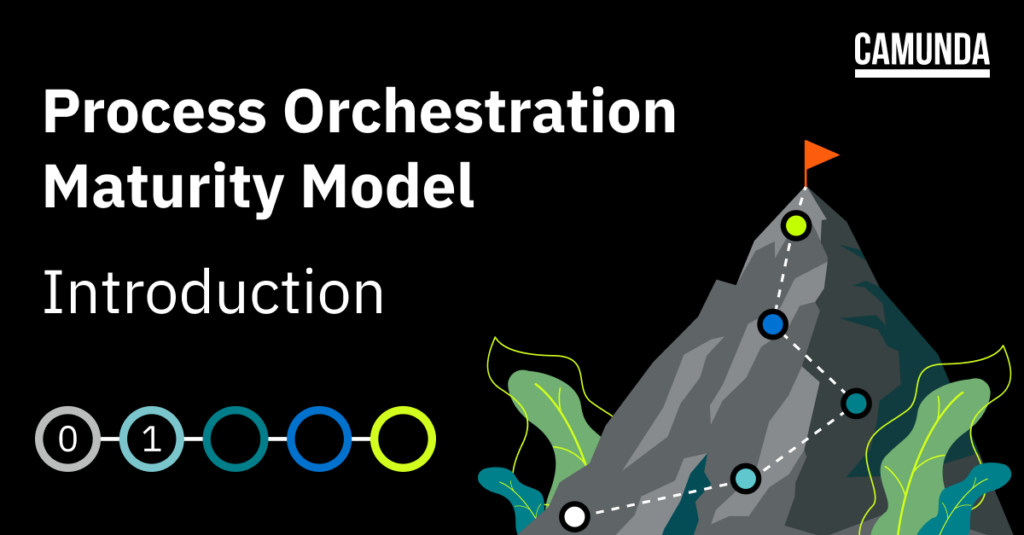What is the maturity model and what are Levels 0 and 1? Welcome to the first blog in our series on the Process Orchestration Maturity Model.
Process Orchestration Maturity Model
In this blog series we’ll be discussing how you can advance your process orchestration maturity to overcome business challenges and understand where to focus in the future. But before we get started on how to achieve various levels of the maturity model, it is important to understand what process orchestration is and how the Process Orchestration Maturity Model helps you improve it.
What is process orchestration?
Process orchestration coordinates moving parts (or endpoints) of a business process. It often ties multiple processes together helping you to work with the people, systems, and devices you already have – while achieving even the most ambitious goals around end-to-end process automation. Essentially, process orchestration helps tie together different business processes, including both automated and manual ones.
What is the Process Orchestration Maturity Model?
As companies begin to look at their automation goals, there are different factors and drivers that help them assess their maturity around process orchestration. These drivers are described below:

What is the awareness of process orchestration as a distinct competency in the organization? Why does it matter to the organization?

What goals are the organization trying to achieve through its process orchestration practice?

Who defines the standards and policies for how process orchestration should be used? Who is responsible for implementing these changes?

How does the organization define process orchestration success? How capable is the organization at tracking that success?

What technology philosophies, platforms, and solutions power the organization’s process orchestration efforts?
In order to progress toward process orchestration maturity, organizations must feel comfortable at each level and be able to execute process orchestration projects and strategies across these drivers. Taking these steps will inform them of their maturity as well as improve their ability to overcome challenges that might be blocking their automation goals.
There are many things that can impede a company’s journey to process orchestration maturity including:
- Too many people involved to automate processes
- Mounting legacy infrastructure costs
- Lack of strategic oversight and visibility
- Lack of integration capabilities
- Performance, reliability and scalability problems
The key is to find out where you are on the maturity model by looking at the five levels and then use this information to determine the key focus areas for your efforts. Then you can extract the highest value from both your new and existing digital transformation investments.

But why? Why does this really matter? Bottom line—there are consequences to organizations that are not implementing process orchestration or not implementing it in a way that positions them for future growth. In fact, some of these companies experience:
- Broken or inefficient customer experiences
- Unnecessary inefficiency due to poorly identified, implemented, executed, and maintained processes
- Inability to measure effectiveness or continuously improve automated processes
Compare that to companies that are highly mature in their process orchestration:
- Marked improvements in customer experience, driving revenue opportunity
- Greater internal efficiency, lowering costs
- Higher degree of overall automation, driving digital transformation initiatives
So, now that you have a basic understanding of the process orchestration maturity model, let’s discuss Level 0 and Level 1 of the model.
Nothing is orchestrated—that’s Level 0
If your organization has not orchestrated any processes—you are soundly at Level 0 in the process orchestration maturity model. If you map your current status against the five maturity drivers, it might look something like this:

You may have automated some process elements, but there is no way to measure their impact to the process or the organization.

Your organization is interested in improving inefficient processes even if they
haven’t started this yet.

Your IT team may not be configured to allow for centralizing resources or projects
at this time.

You are currently unable to accurately measure business value from process
orchestration or automation.

Your company may have implemented disparate automation technologies.
Let’s take a look at a fictitious insurance company, Camundanzia Insurance, and see how they stack up in the maturity model at this level.
Camundanzia Insurance at level 0
At Camundanzia, nothing is automated, they are in the dark ages. They have issues around automobile claims. Here’s the current “process:”
- When the first notice of loss (FNOL) comes in, Camundanzia still creates a manila folder for the claim and labels it with the claim number generated from the mainframe Claims Management System.
- The claim folder is either walked over to the Policy Administration department or it goes to them by interoffice mail. That department prints a copy of the policy from the Policy Administration System and adds it to the file. The exterior tracking sheet for the claim is updated with the adding of the policy, the date and if the policy is in effect or no longer valid.
- The file goes again through interoffice mail to the adjusters who review the information, determine the proper adjuster for the claim. That adjuster reaches out to the insured to make arrangements to review and estimate the vehicle damage.
- This process is complicated if there is a medical injury involved. In this case, when the adjuster finishes the work, the file is sent to the Medical Review department to review the associated medical claim.
- Finally, once all the information is assembled, the Accounting department obtains the folder, calculates the payment and communicates with the insured to send payment.
Let’s face it—this entire process is cumbersome and completely manual. Claim folders are misplaced and information gets lost. In addition, everything is very slow and nothing is done at the same time. It is a very serial process. It is virtually impossible to be able to tell a claimant where the claim is in Camundanzia at any given time. So, as shown here, Camundanzia Insurance is at level 0 in the Process Orchestration Maturity Model.
Level 1—A single project has been completed
To get to level 1, you need to start with a single project as the next step in your automation journey. You do want to carefully select the project, however. It is recommended that you select a process that has a significant impact. This can be a process that is currently “broken”—similar to the claims process at Camundanzia.
Let’s look again at how you might stack up against the five drivers:

Your team may now be focused on single, mission-critical process orchestration projects that can have a direct positive impact on the organization.

There is a more urgent need to “fix” broken/inefficient mission-critical processes.

The team often takes a decentralized, “sprouting mushroom approach” to disparate process orchestration projects.

You are concentrating on completing single high-need projects.

You still support legacy systems or monolithic on-premise solutions.
So, you are making strides in the right direction to achieve the next level of the maturity model. As you look for the first project, you want to make sure that you carefully analyze the process. You need to gather data from all your departments and review the systems involved in the process. Look at how long it takes to complete tasks and the entire process overall. Review the technology and see how it is used.
Taking the time to gain insight into your current process can help you clarify your vision of how to approach your single process orchestration with the future in mind. You can use this information to fix inefficiencies and target process improvements.
Let’s take a look at how Camundanzia achieved level 1 of the Process Orchestration Maturity Model.
Level 1 for Camundanzia Insurance
So, Camundanzia’s Net Promoter Scores (NPS) are falling and customer retention has been plummeting year over year. The reality is that their claims process is broken and customers are very unhappy because Camundanzia has no insight into where claims are, so customers are left in the dark about their status. In addition, they often lose claim information and the processing is much slower than the industry average.
The claim process involves multiple departments that are disconnected and, as a result, there is no real flow of information between them. They need to change this quickly because they are losing customers and the company is suffering.
So, Camundanzia has determined this was the perfect project to progress them to level 1 on their process orchestration journey. They started with an initial flow that begins by connecting the departments—even if just to pass information to each department. Using some out of the box Connectors, Camundanzia can communicate with their customers on claim status for a start.

Using the BPMN process created by Camundanzia, they were able to even implement a connection to the Policy Administration System and the Claims Management System to update information with details from the process.
Camundanzia is solidly in Level 1 of the maturity model. They have tackled a highly visible process and provided some improvements by:
- Reaching out to the customer with a claim status.
- Connecting the disparate departments together to streamline the process.
- Added integration to different systems to minimize human error.
This places Camunda in a great position to achieve the next level of the process orchestration maturity model.
Want to see more details about how you can take a claims processing example like this one to Level 1 (and beyond)? Learn how in this Claims Process Automation Guide.
Stay tuned for Level 2
We hope you enjoyed this first blog in our series about the Process Orchestration Maturity Model. Don’t forget to check out the next blog on achieving Level 2.
If you want to read more about this topic, please check out this webpage or click below.
You can also review the webinar: Process Orchestration Maturity: A Practical Journey to hear about all levels and examples.


Start the discussion at forum.camunda.io